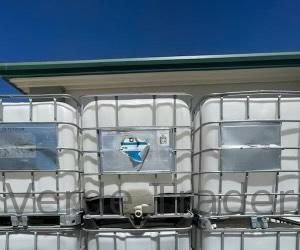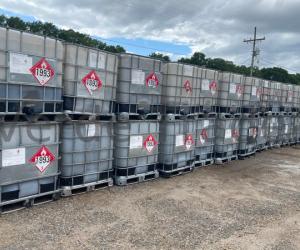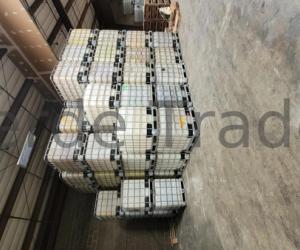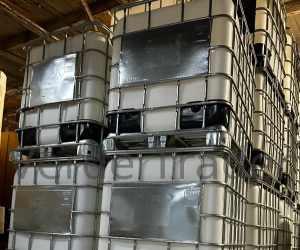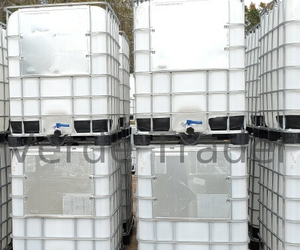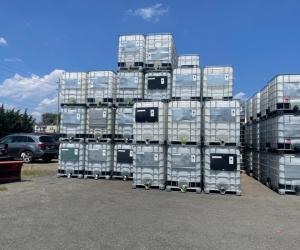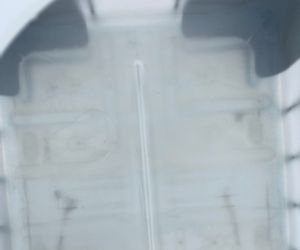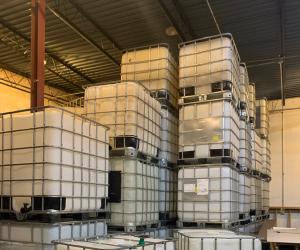Used IBC Totes For Sale
As is Tank & Cage - Not Cleaned
Used Dirty IBC Totes
See More →As is Tank & Cage - Lightly Rinsed
Used Rinsed IBC Totes
See More →As is Tank & Cage - Steam Cleaned
Used Steam Cleaned
See More →Reconditioned IBC Totes
Refurbished Bottle & Cage
See More →Used IBC Totes
Used IBC totes are Caged IBC totes used for the transportation, storing, or distributing of liquid materials that have been filled with a liquid product at least once. In many instances, used tanks can be reused again and again, which makes them a safe and cost-effective solution for storing products. A container that has been used at least once is considered used. Whether recertified or washed out, they are not new.
Used Rinsed IBC Containers
Reconditioned IBCs
Frequently Asked Questions
What is an used IBC tote?
IBC containers that have been used at least once are considered used. They are not new, even if they have been recertified.
Are they stackable?
Yes, used IBC totes are stackable. Unless the cage's foot is damaged and it is unable to sit level on the flat surface.
What are they used for?
Without cleaning or rebottling, most used containers have no purpose or value. It is common to find people using them on the internet for aquaponics, chicken coops, giant trash bins, and rainwater collection. When purchasing used containers, be wary of their prior contents, as they may contain hazardous substances.
Are there different kinds of used IBC totes?
IBCs that have been reconditioned, rebottled, rinsed, or dirty are still considered to be used.
Can used IBC totes be used for potable water?
IBC totes should never be used for potable water, no matter what the circumstances may be. It is possible for even food-grade materials to cause serious health problems.
What are the dimensions?
275 Gallon - 40″L x 48″W x 46″H & 330 Gallon - 40″L x 48″W x 54″H
How many fit on a truck?
60 used containers fit on a truck.
How much do used IBCs cost?
Depending on the type of used tote you choose, prices can range anywhere from $10.00 to $300.00.
Risks of Purchasing Unrinsed, Rinsed, and Triple Rinsed Used IBC Totes
Unrinsed or Dirty – High risk of contamination
A 275 gallon or 330 gallon unrinsed tank is one that has been emptied, but not washed. It is likely that it still contains more than 10 to 15 gallons of the chemical or product that it was formerly filled with.
It is recommended that the general public avoid unrinsed, non-food grade totes due to the negative effect they may have on the environment and the user’s health.
Rinsed – High risk of contamination
Used IBC Totes that have been lightly washed with cold water are easier to return to the manufacturer or recycler. Despite being rinsed, previous products remain inside the containers.
Reasons why a tote would be rinsed IBC totes just once
Rinsing hazmat totes renders them non-hazmat, thereby eliminating the need for hazmat carriers to transport the empties
After rinsing totes that contain adhesives or glue, it is easier to clean them professionally to avoid having the product harden
Rinsing the inside of the bladder can prevent discoloration.
Beware when buying a rinsed tote, keep in mind that some residue could remain from its previous contents because these haven’t been thoroughly sanitized.
Triple Rinsed – High risk of contamination
Triple rising is an industry-standard developed with consumers of Agriculture IBC totes, this method was developed to effectively and efficiently remove pesticides from the totes, by carefully rinsing the totes three times can remove most of the previous product. A triple rinse sticker may be applied to the container once the process has been completed.
Beware when buying a rinsed tote, keep in mind that some residue could remain from its previous contents because these haven’t been thoroughly sanitized.
Be Cautions! This doesn’t mean the Tote is 100% clean.
Why would you triple rinse?
- Follow EPA guidelines.
- Prepare your tanks for recycling/refilling.
- Cost-effective solution for disposal.
EPA regulations require that IBC totes be triple rinsed after handling pesticides, depending on the severity of the product the be marked as non-refillable.
In some cases, non triple rinsed IBC tanks with previous agricultural products can even cost you money when it comes to disposal!
Reconditioned – Low risk of contamination
Reconditioned caged IBCs are used tanks that have gone through a number of inspections and a thorough cleaning process.
- Visually inspected for leaks and damage
- Repaired galvanized steel cage
- Rinsed with 165 degree water
- Chemical rinse depending on the product that was last contained
- Cold water rinse
- Pressure tested to ensure the valve will not leak
- Visually inspected for quality
- Marked with a recertification date on the front faceplate
IBC reconditioning and recertifying companies are part of the DOT and EPA’s regulatory framework.
Understanding the Unknown Content in Used IBCs
Unknown Content
An unknown mark on a container indicates that, despite our efforts, we cannot accurately determine what it held in the past. AVOID PURCHASING USED 275 or 330 gallon intermediate bulk containers whose contents are unknown!
Non-Hazmat
The SDS states in section 14 that the DOT and other regulatory bodies consider the product safe for transport and that it does not require special markings for transportation or pose a major health risk. Spillage of non-hazmat products can be extremely hazardous to the environment and may even cause health and safety problems.
Common products include:
- Glue
- Paint
- Motor oil
- Food products
Food-grade
There is no guarantee that a substance previously classified as food is safe for human consumption. As the name implies, the former contents consisted of food products. To determine whether your tank is food grade, look for the FDA sticker on the faceplate.
Among the most popular food grade products are:
- Syrups
- Food oils
- Alcohol
- Cleaning supplies
It is important to note that many food-grade products are classified as hazmat. Because these products are regulated by the Environmental Protection Agency and the Department of Transportation, they should not be handled by the general public.
Hazmat
Hazardous materials are chemicals that can cause severe health problems and environmental damage.
The U.S. government has set regulations when it comes to transporting hazardous materials in IBCs, which can be found under Code: 49 CFR § 173.35. This regulation says the following:No hazardous material may remain on the outside of the IBC
Liquid hazardous materials may only be offered for transportation in a metal, rigid plastic, or composite IBC that is appropriately resistant to an increase in internal pressure likely to develop during transportation.
Typical hazmat products you’ll find in a tote:
- Caustics
- Acids
- Pesticides
- Oil gas products
Check the faceplate of your tank for a sticker that states the packaging class, hazardous class, and UN number.
Used IBCs and Their Prices
Cost effective
A used 275 gallon or 330 gallon plastic caged IBC’s price depends entirely on whether the seller has been certified by the EPA and the DOT to refurbish containers.
The vast majority of local sellers advertising on Facebook and Craigslist are selling containers from their backyards and are unable to properly dispose of the left-over product.
Therefore, the price for a used tote from a legitimate company will be higher. Used or refurbished totes cost the following regardless of their legitimacy:
- Unrinsed – $10 to $65
- Rinsed – $35 to $120
- Triple Rinsed – $35 to $120
- Reconditioned – $120 to $150
- Rebottled – $150 to $220
Widely available
In case you are only interested in a few, we suggest looking on Facebook marketplace or craigslist.
Verde Trader mainly deals in the wholesale and distribution of used containers at this time, and cannot fill smaller orders.
Longevity
Used IBCs purchased by a non-commercial end user may last up to ten years if kept out of the elements in a dark area.
Nevertheless, containers that continue to be used within commercial facilities are deemed unsuitable after two years by the DOT and EPA, and are usually rebottled or disposed of.
Confirm Used IBC Suits Your Requirements: A Step-by-Step Guide
- Collect the sds data sheets to confirm that the product previously in the container is actually deemed safe
- Verify chain of custody
- Verify the container has not been used for other purposes
- Verify that the the container is RCRA empty – https://www.hazardouswasteexperts.com/empty-vs-rcra-empty-knowing-the-difference/
Dangers of Drinking Out of a Used Tote
Health problems can result from drinking out of a used tote.
Nevertheless, they were designed not to collect water for human consumption, but to maximize shipping capacities, allowing chemical and food manufacturers to transport more than a 55 gallon barrel, and less than a full tanker.
A tote may contain a variety of chemicals, agriculture products, or other ingredients, therefore making it dangerous to drink out of one without knowing and verifying what’s inside.
There is a theory that drinking out of a food grade tote may be safe, and many sellers on social media claim they know what the container previously held, but there is no way for the seller to determine whether the manufacturer used the container for other purposes other than transport and storage.
Many manufacturers reuse their totes for waste water and mixing other chemicals.
To ensure your safety and the safety of those around you, it is best to purchase a rebottled tote; these containers have a new FDA approved plastic bladder inside of a reconditioned steel cage.
Finding Quality Used IBCs for Your Business Needs
Verde Trader & IBC Tote Recycling
Providing quality service to both manufacturers and consumers, IBC Tote Recycling & Verde Trader was founded in 2017. Our company offers the largest selection of used IBC totes and works with IBC recyclers throughout the country to ensure bulk containers are properly recycled.
Our large selection is easily accessible, and bulk pricing is available. We can provide more information on used 275 gallon and 330 gallon manufactured containers upon request.
Verde Trader is a used industrial packaging marketplace. Our goal is to service companies all of sizes.

